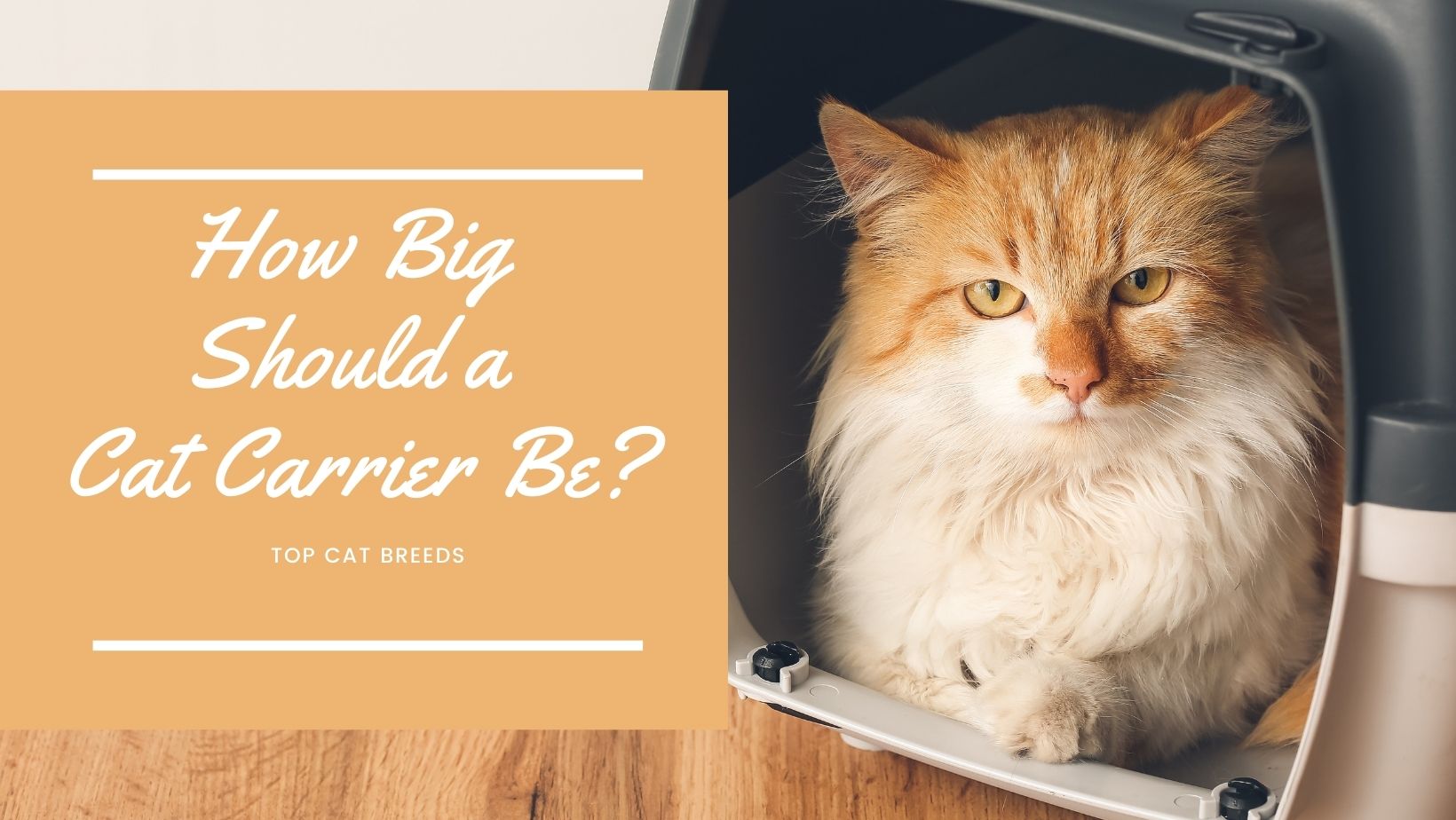
Having the right carrier is an important step in making sure that your cat is safe and secure. It can help make traveling easier for both of you. A loose cat can climb into the car, such as under the pedal or in front of the steering wheel.
If they get frightened, they could scratch or injure you. If they’re not secured, they can bolt from the vehicle or get lost. There are various types of carriers available for cats. When it comes to choosing the right one, you can usually find it in a variety of colors and materials. An important question to ask is, how big should a cat carrier be?
From the perspective of the cat, it’s important to understand that having the right carrier can help make your pet feel secure and safe when traveling. Having the right carrier can also help them hide out in a variety of ways.
How to Calculate to Get the Right Size?
Before you buy a carrier, make sure that the cat is placed next to a wall and has a natural standing position. This will help determine the size of the carrier.
Before buying a cat carrier, it’s important to consider the purpose of the trip and the type of animal that will be using it. Also, make sure that the carrier has enough space for a litter tray and a water bowl.
If you can’t afford a cat carrier, then get one that can accommodate all of your cat’s needs. However, it should also leave enough room for your cat to move around. The size of the carrier is also a factor to consider when choosing one for your cat. You can also choose between a soft-sided and a hard plastic carrier.
A soft-sided carrier is ideal for cats since it can be easily transported in tight spaces. If you plan is taking your pet on an airplane, then a soft-sided carrier is a must. Ideally, a hard carrier should be used for transporting cats inside the car. It provides better protection from the weather and is sturdier than a soft one.
Aside from the size of the carrier, you also need to consider the various features that it has to offer. Some of these include handles, plastic peg holders, and sliding plastic locks. It’s also important to find a carrier that has a built-in safety feature to prevent your cat from getting out. There are a few safety features that you should look for in a soft carrier.
If you’re still confused about the size of the carrier that’s right for your pet, then jetpets.com.au has a helpful calculator that will help you figure out the ideal size. The calculator will help you determine the minimum size of a carrier that you need to buy for your cat.
The calculator will then take into account the data that you provide and will come up with the ideal size. To get started, first input the length of your pet’s tail and the height of its nose. Then, input the distance between the elbow joint and the ground and the ear of your cat. You can then use the calculator to answer two additional questions. One of these is if your pet has a snubbed nose.
After collecting all the necessary information, the calculator will automatically calculate the minimum size that you need to buy for your pet.
What Happens if a Cat Carrier Is Too Big?
The size of the cat carrier is also an important factor to consider when it comes to your cat’s welfare. A large cat carrier can make your cat feel very scared and hide in a corner.
Before you buy a carrier for your cat, make sure that it can accommodate your cat’s movement without causing any hindrance. This is a tool that will help you determine if the size of your cat carrier is ideal for you.
Take a tape measure and determine the length of your cat’s tail and nose using the same method. There is no guarantee that you will get the exact length of the carrier for your cat. However, if you can get the closest one, try it out. Ideally, a cat carrier should have a length of 12 inches. However, if you can’t find one that fits your animal, you might want to look for an 11” or 13” carrier.
What Happens if a Cat Carrier Is Too Small?
There are a few reasons why I hate cats who are kept inside small carriers. Being kept in a small carrier makes them feel like they are imprisoned.
If the cat carrier is too small, it will prevent your cat from moving around properly. It will also cause discomfort to your pet’s delicate body. Being inside a small carrier can also suffocate a cat very quickly. Also, if the trip is long, your pet might get sick.
Being forced to get into a small carrier is inhumane. You won’t like it if someone forces you to spend several hours in a small space.
The carrier should be big enough to allow your cat to stand up and turn around. If you have a small cat, then this rule doesn’t apply. Since cats have a large growth rate, they outgrow their carriers very quickly. This causes you to buy a new one again.
Before buying a new carrier for your cat, you must know what size it will be when it grows up. Take into account their current size and breed to get an idea of what size it will be when it reaches adulthood.
What Size Carrier Do I Need?
The size of the cat carrier should be larger than the crate to give your cat more room to move around. This will allow them to stretch out more easily. If you’re looking at your cat, then make sure that the carrier has the right size for them. Just look at them and see if they can stand up without getting bogged down.
If you are planning on taking your cat to the vet, then this is the size that will fit most of your cat’s needs. There are various types of cat carriers out there, so it is important to figure out what size will work best for your cat.
The following are the kinds of materials for a cat carrier that you can choose from:
Sturdy Material
A sturdy carrier made of sturdy material will provide better comfort for your pet and can be cleaned better than a cardboard one.
Multiple Entry Points
A good carrier will have multiple entry points so that you can choose the method of entry that works best for your cat. It can also enable them to feel more relaxed.
With Privacy
A carrier that has the option to cover the windows or mesh will allow your cat to breathe more easily and feel more secure.
Cozy
Having a wide and tall carrier will also help your cat feel at home. It should also have one of its favorite blankets to keep them warm during times of uncertainty.
Half and Half
If you have a cat that gets nervous when going to the vet, then split the carrier in half. This method will allow the expert to examine them while they are in the comfort of their blanket.
Perfect Size
The size of the carrier is also very important, as it should be 1.5x bigger than its actual size. If they have a large breed, such as a Maine Coon, you’ll need to look for an extra-large one.
Is It Alright to Put More Than One Feline in a Carrier?
Ideally, people with multiple cats should put them all in the same carrier to save money. However, this can be done depending on the size of the cats and their personalities.
If you get a large carrier, it’s generally okay to have one small cat and one medium-sized cat in the same one. But, this can only work if both cats can ride properly and don’t move around too much.
Putting two cats in the same carrier can cause a fight if one is anxious while traveling. To avoid this mistake, I have listed above the best carriers for cats. Getting cats separated will keep them from each other and will allow you to focus on their needs. It will also keep the carrier clean and prevent accidents.
Read also: Best Cat Carrier For Car Travel – Updated Guide
Conclusion
Having a cat carrier is important for keeping your pet’s stress at bay while they’re at the veterinarian’s office. It can help decrease their anxiety and provide them with a safe environment to rest. You can also use a pheromone spray to calm them before they enter the carrier.
An appropriately sized carrier with bedding or towel in the bottom will prevent your pet from sliding around in it, which will help with car sickness. It can also be cleaned easily to prevent the cat from getting defecated or vomited.
The carrier should be well-ventilated and can be covered with a light blanket or towel to provide a dark and protected space for your cat. Having multiple entry points and doors will allow your pet to explore and look around the carrier.
Read also: How to Get an Aggressive Cat Into a Carrier – Proven Methods!

